 Reference images:
Reference images:
-
 Artist: Utagawa Kuniyoshi [歌川 國芳] (1798 – 1861). Kabuki actors Ichikawa Danjūrō VIII and Arashi Rikan III as sumo wrestlers Nuregami Chōgorō (L) and Hanaregoma Chōkichi (R), respectively. Signed: Ichiyûsai Kuniyoshi ga (一勇斎 國芳 画) in a double gourd-shaped cartouche with Yoshi Kiri seal. Publisher: No seal. Date seal and double nanushi censor seal: Mera & Watanabe, 1852. Media: Fan print (uchiwa-e, 団扇絵), 231 x 295 mm. Theme: Nine-act drama (11 scenes) Futatsu Chōchō Kuruwa Nikki [双蝶々曲輪日記] (A Diary of Two Butterflies in the Pleasure Quarters) written by Takeda Izumo II, Namiki Senryū I, Miyoshi Shōraku (7/1749) as puppet play Bunraku [文楽], adopted for Kabuki theatre by Arashi San'emon IV. “The sumo wrestler Nuregami Chōgorō is trying to ransom the courtesan Azuma for Yogoro, in whose debt he stands. Hiraoka Goemon, who is at odds with Yogorō and Azuma, is the patron of the amateur wrestler Hanaregoma Chōkichi. Chōgorō purposely loses to Chōkichi and then asks the latter to stop Goemon's ransoming of Azuma; Chōkichi refuses, however, and they quarrel. Admonished for his dissipation by his sister Oseki, Chōkichi is going to commit ritual suicide (seppuku) as an apology for his behavior, but Chōgorō, who happens along just then, prevents him. The two men swear blood brotherhood. […] The confrontation between Chōgorō and Chōkichi in the Sumōba scene, acted in the exaggerated style called aragoto, is a major highlight of the work. The scene in Yohei's home, known as Hikimado, presents the unfolding of Kabuki's eternal conflict between duty and feelings, here represented by the act of opening the skylight (hikimado) to which Chōgorō is tied”. [Samuel L. Leiter. Kabuki Encyclopedia: an English-language adaptation of Kabuki Jiten. — Westport, CT; London: Greenwood Press, 1979, pp. 70-71]. See also James R. Brandon and Samuel L. Leiter. Kabuki plays on stage, vol. 1, pp. 234-258. — Honolulu: University of Hawai'i Press, 2002. Actors: Ichikawa Danjūrō VIII [市川団十郎] (Japanese, 1823 – 1854); other names: Ichikawa Ebizō VI, Ichikawa Shinnosuke II. Arashi Rikan III [嵐璃寛] (Japanese, 1812 – 1863); other names Arashi Tokusaburō III, Arashi Kicchō I, Onoe Wasaburō I. Another print in this collection with the same theme: SVJP-0331.2020.
Artist: Utagawa Kuniyoshi [歌川 國芳] (1798 – 1861). Kabuki actors Ichikawa Danjūrō VIII and Arashi Rikan III as sumo wrestlers Nuregami Chōgorō (L) and Hanaregoma Chōkichi (R), respectively. Signed: Ichiyûsai Kuniyoshi ga (一勇斎 國芳 画) in a double gourd-shaped cartouche with Yoshi Kiri seal. Publisher: No seal. Date seal and double nanushi censor seal: Mera & Watanabe, 1852. Media: Fan print (uchiwa-e, 団扇絵), 231 x 295 mm. Theme: Nine-act drama (11 scenes) Futatsu Chōchō Kuruwa Nikki [双蝶々曲輪日記] (A Diary of Two Butterflies in the Pleasure Quarters) written by Takeda Izumo II, Namiki Senryū I, Miyoshi Shōraku (7/1749) as puppet play Bunraku [文楽], adopted for Kabuki theatre by Arashi San'emon IV. “The sumo wrestler Nuregami Chōgorō is trying to ransom the courtesan Azuma for Yogoro, in whose debt he stands. Hiraoka Goemon, who is at odds with Yogorō and Azuma, is the patron of the amateur wrestler Hanaregoma Chōkichi. Chōgorō purposely loses to Chōkichi and then asks the latter to stop Goemon's ransoming of Azuma; Chōkichi refuses, however, and they quarrel. Admonished for his dissipation by his sister Oseki, Chōkichi is going to commit ritual suicide (seppuku) as an apology for his behavior, but Chōgorō, who happens along just then, prevents him. The two men swear blood brotherhood. […] The confrontation between Chōgorō and Chōkichi in the Sumōba scene, acted in the exaggerated style called aragoto, is a major highlight of the work. The scene in Yohei's home, known as Hikimado, presents the unfolding of Kabuki's eternal conflict between duty and feelings, here represented by the act of opening the skylight (hikimado) to which Chōgorō is tied”. [Samuel L. Leiter. Kabuki Encyclopedia: an English-language adaptation of Kabuki Jiten. — Westport, CT; London: Greenwood Press, 1979, pp. 70-71]. See also James R. Brandon and Samuel L. Leiter. Kabuki plays on stage, vol. 1, pp. 234-258. — Honolulu: University of Hawai'i Press, 2002. Actors: Ichikawa Danjūrō VIII [市川団十郎] (Japanese, 1823 – 1854); other names: Ichikawa Ebizō VI, Ichikawa Shinnosuke II. Arashi Rikan III [嵐璃寛] (Japanese, 1812 – 1863); other names Arashi Tokusaburō III, Arashi Kicchō I, Onoe Wasaburō I. Another print in this collection with the same theme: SVJP-0331.2020. Reference images:
Reference images:
-
 Artist: Utagawa Kuniyoshi [歌川 國芳] (1798 – 1861). A beauty leaning on a fence and watching a dragonfly hovering above a flowering plant. Signed: Ichiyûsai Kuniyoshi ga (一勇斎 國芳 画) in a double gourd-shaped red cartouche. Publisher: Maruya Jinpachi, seal Jin [甚] (Marks 08-088 | 294d). No date/censor seal. Media: Fan print (uchiwa-e, 団扇絵), 234 x 301 mm.
Artist: Utagawa Kuniyoshi [歌川 國芳] (1798 – 1861). A beauty leaning on a fence and watching a dragonfly hovering above a flowering plant. Signed: Ichiyûsai Kuniyoshi ga (一勇斎 國芳 画) in a double gourd-shaped red cartouche. Publisher: Maruya Jinpachi, seal Jin [甚] (Marks 08-088 | 294d). No date/censor seal. Media: Fan print (uchiwa-e, 団扇絵), 234 x 301 mm. -
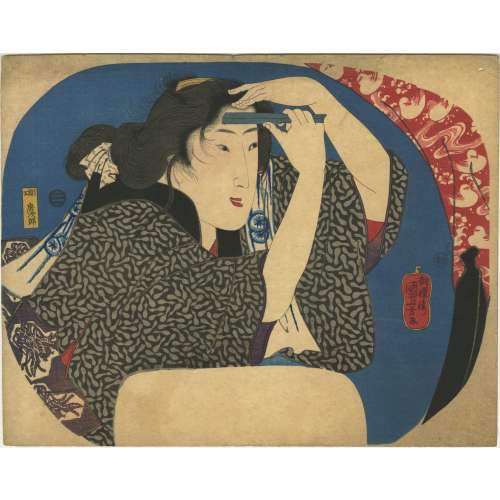 Artist: Utagawa Kuniyoshi [歌川 國芳] (Japanese, 1798 – 1861). Publisher: Ibaya Senzaburō [伊場屋仙三郎] (Japanese, fl. C. 1845 – 1847), seal: San [三] (Marks 11-001 | 127c). Carver: Matsushima Fusajirō [松嶋房次郎] (Japanese, fl. 1843 – 1850); seal [彫工房次郎] – Hori kō Fusajirō (Gordon Friese № 136) Signed: Chōōrō Kuniyoshi ga [朝櫻楼国芳画] in a red double gourd-shaped cartouche. Nanushi censor seal: Tanaka [田中]; V/1844 or II/1845. Media: Fan print (uchiwa-e, 団扇絵), 238 x 304 mm. Reference: Kuniyoshi Project. Series mentioned in Robert Schaap. Heroes and ghosts: Japanese prints by Kuniyoshi, 1797-1861.— Leiden: Hotei Publishing, 1998; p. 122 [LIB-1030.2016].
Artist: Utagawa Kuniyoshi [歌川 國芳] (Japanese, 1798 – 1861). Publisher: Ibaya Senzaburō [伊場屋仙三郎] (Japanese, fl. C. 1845 – 1847), seal: San [三] (Marks 11-001 | 127c). Carver: Matsushima Fusajirō [松嶋房次郎] (Japanese, fl. 1843 – 1850); seal [彫工房次郎] – Hori kō Fusajirō (Gordon Friese № 136) Signed: Chōōrō Kuniyoshi ga [朝櫻楼国芳画] in a red double gourd-shaped cartouche. Nanushi censor seal: Tanaka [田中]; V/1844 or II/1845. Media: Fan print (uchiwa-e, 団扇絵), 238 x 304 mm. Reference: Kuniyoshi Project. Series mentioned in Robert Schaap. Heroes and ghosts: Japanese prints by Kuniyoshi, 1797-1861.— Leiden: Hotei Publishing, 1998; p. 122 [LIB-1030.2016].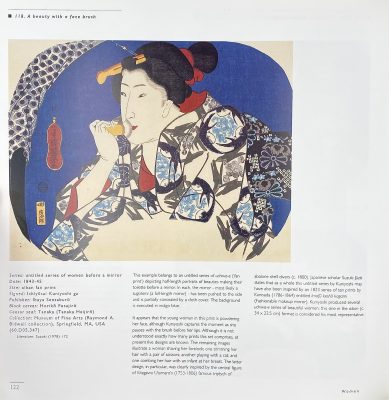
-
 Artist: Utagawa Kunisada [歌川 国貞], a.k.a. Utagawa Toyokuni III [三代 歌川 豊国] (Japanese, 1786 – 1865). Signed: Toyokuni ga [豊国 画] in a red toshidama cartouche Block carver: Yokokawa Takejirō [横川竹二郎] (Japanese, fl. 1845 – 1863), seal: 彫竹 – hori Take. Publisher: Ibaya Senzaburō [伊場屋仙三郎] (Japanese, fl. c. 1845 – 1847). Media: Untrimmed fan print (uchiwa-e), 238 x 304 mm. Title: Saiko (West River) [西江]; 西江 means the Xi River in China. Series: Chronicles of Elegant Women [風雅女史傳] (Fūga joshiden). Combined date seal and kiwame censor seal: Ansei 6 (1859). Other prints from the same series in this collection: SVJP-0216.2016 — Princess Sotoori:
Artist: Utagawa Kunisada [歌川 国貞], a.k.a. Utagawa Toyokuni III [三代 歌川 豊国] (Japanese, 1786 – 1865). Signed: Toyokuni ga [豊国 画] in a red toshidama cartouche Block carver: Yokokawa Takejirō [横川竹二郎] (Japanese, fl. 1845 – 1863), seal: 彫竹 – hori Take. Publisher: Ibaya Senzaburō [伊場屋仙三郎] (Japanese, fl. c. 1845 – 1847). Media: Untrimmed fan print (uchiwa-e), 238 x 304 mm. Title: Saiko (West River) [西江]; 西江 means the Xi River in China. Series: Chronicles of Elegant Women [風雅女史傳] (Fūga joshiden). Combined date seal and kiwame censor seal: Ansei 6 (1859). Other prints from the same series in this collection: SVJP-0216.2016 — Princess Sotoori:

-
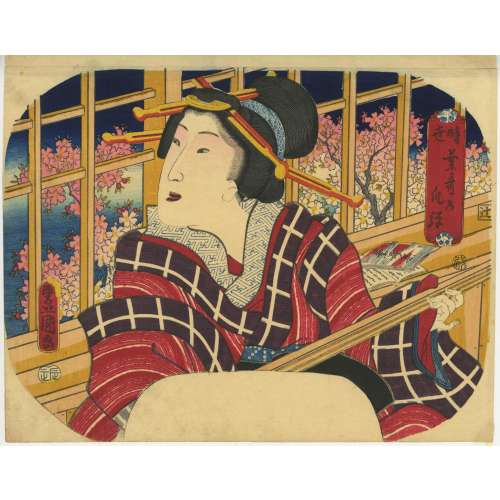 Artist: Utagawa Kunisada [歌川 国貞], a.k.a. Utagawa Toyokuni III [三代 歌川 豊国] (Japanese, 1786 – 1865). Signed: Toyokuni ga [豊国 画] in a red toshidama cartouche Publisher: Iseya Ichiemon [伊勢屋市右衛門] (Japanese, fl. c. 1820s – c. 1860s); seal Tsuji [辻] (Marks 16-029). Media: Untrimmed fan print (uchiwa-e), 225 x 295 mm, plus 10 mm paper strip glued on top (235 mm total height). Title: Plucking Popular Songs in Those Days [時世葉歌の爪弾] (Imayo ha-uta no tsuma-biki). Date seal and aratame seal: Ansei 3 (1856). Seller's Description: Uchiwa-e; picture intended for a summer fan. Here we see a relaxed beauty wearing loose layers of kimono and playing her shamisen instrument. She appears to be in the happy mood of spring, her singing inspired by the cherry blossoms in full bloom that we see outside of her window. She enjoys leisurely plucking with the plectrum of the shamisen and singing “ha-uta” (popular) songs. The title Ha-uta [葉歌] is normally written 端歌, which indicates a certain category of popular songs accompanied by shamisen with short texts that are drawn from daily life. Here however, the title葉歌 uses phonetically the same “ha葉“, referring to the title of the book of a collection of ha-uta songs, Matsu no ha [松の], which was published in five volumes in 1703 by Shûshôken 秀松軒. It is said that this collection of songs was written and sung by the blind (who were often musicians by livelihood). Behind her, lying on the window sill, we see two ha-uta songbooks, one open and one closed. The last half of the title tsuma-biki [爪弾] translates “to pluck with fingers” instead of a plectrum, which is the usual way of playing the shamisen.
Artist: Utagawa Kunisada [歌川 国貞], a.k.a. Utagawa Toyokuni III [三代 歌川 豊国] (Japanese, 1786 – 1865). Signed: Toyokuni ga [豊国 画] in a red toshidama cartouche Publisher: Iseya Ichiemon [伊勢屋市右衛門] (Japanese, fl. c. 1820s – c. 1860s); seal Tsuji [辻] (Marks 16-029). Media: Untrimmed fan print (uchiwa-e), 225 x 295 mm, plus 10 mm paper strip glued on top (235 mm total height). Title: Plucking Popular Songs in Those Days [時世葉歌の爪弾] (Imayo ha-uta no tsuma-biki). Date seal and aratame seal: Ansei 3 (1856). Seller's Description: Uchiwa-e; picture intended for a summer fan. Here we see a relaxed beauty wearing loose layers of kimono and playing her shamisen instrument. She appears to be in the happy mood of spring, her singing inspired by the cherry blossoms in full bloom that we see outside of her window. She enjoys leisurely plucking with the plectrum of the shamisen and singing “ha-uta” (popular) songs. The title Ha-uta [葉歌] is normally written 端歌, which indicates a certain category of popular songs accompanied by shamisen with short texts that are drawn from daily life. Here however, the title葉歌 uses phonetically the same “ha葉“, referring to the title of the book of a collection of ha-uta songs, Matsu no ha [松の], which was published in five volumes in 1703 by Shûshôken 秀松軒. It is said that this collection of songs was written and sung by the blind (who were often musicians by livelihood). Behind her, lying on the window sill, we see two ha-uta songbooks, one open and one closed. The last half of the title tsuma-biki [爪弾] translates “to pluck with fingers” instead of a plectrum, which is the usual way of playing the shamisen. -
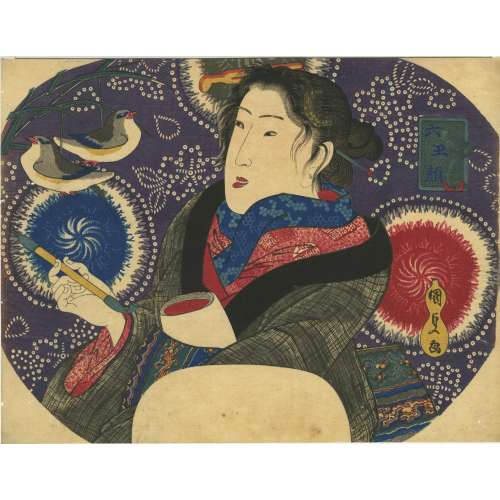 NEWArtist: Utagawa Kunisada [歌川 国貞], a.k.a. Utagawa Toyokuni III [三代 歌川 豊国] (Japanese, 1786 – 1865). Signed: Toyokuni ga [豊国 画] in a yellow double-gourd. Publisher unknown. Media: Untrimmed fan print (uchiwa-e), 228 x 298 mm. Series title: Six Jewel Faces (六玉颜, mu tama-gao), a pun on Six Jewel Rivers (六玉河, Mu Tamagawa). The date seal and censor seal are absent. Another print from the same series in the Metropolitan Museum of New York reads:
NEWArtist: Utagawa Kunisada [歌川 国貞], a.k.a. Utagawa Toyokuni III [三代 歌川 豊国] (Japanese, 1786 – 1865). Signed: Toyokuni ga [豊国 画] in a yellow double-gourd. Publisher unknown. Media: Untrimmed fan print (uchiwa-e), 228 x 298 mm. Series title: Six Jewel Faces (六玉颜, mu tama-gao), a pun on Six Jewel Rivers (六玉河, Mu Tamagawa). The date seal and censor seal are absent. Another print from the same series in the Metropolitan Museum of New York reads:The colorful background, with explosions of tie-dyed floral motifs, is a reminder of how Kunisada made all his thousands of Genji-print designs a visual record of different textile patterns of the day. The title Six Jewel Faces (Mu tama-gao), along with its allusion to the literary theme of Six Jewel Rivers, suggests that this set of fan prints captures the appearance of a half-dozen attractive individuals, and, indeed, the other five works in the set show images of beautiful women, mostly courtesans of the pleasure quarters.
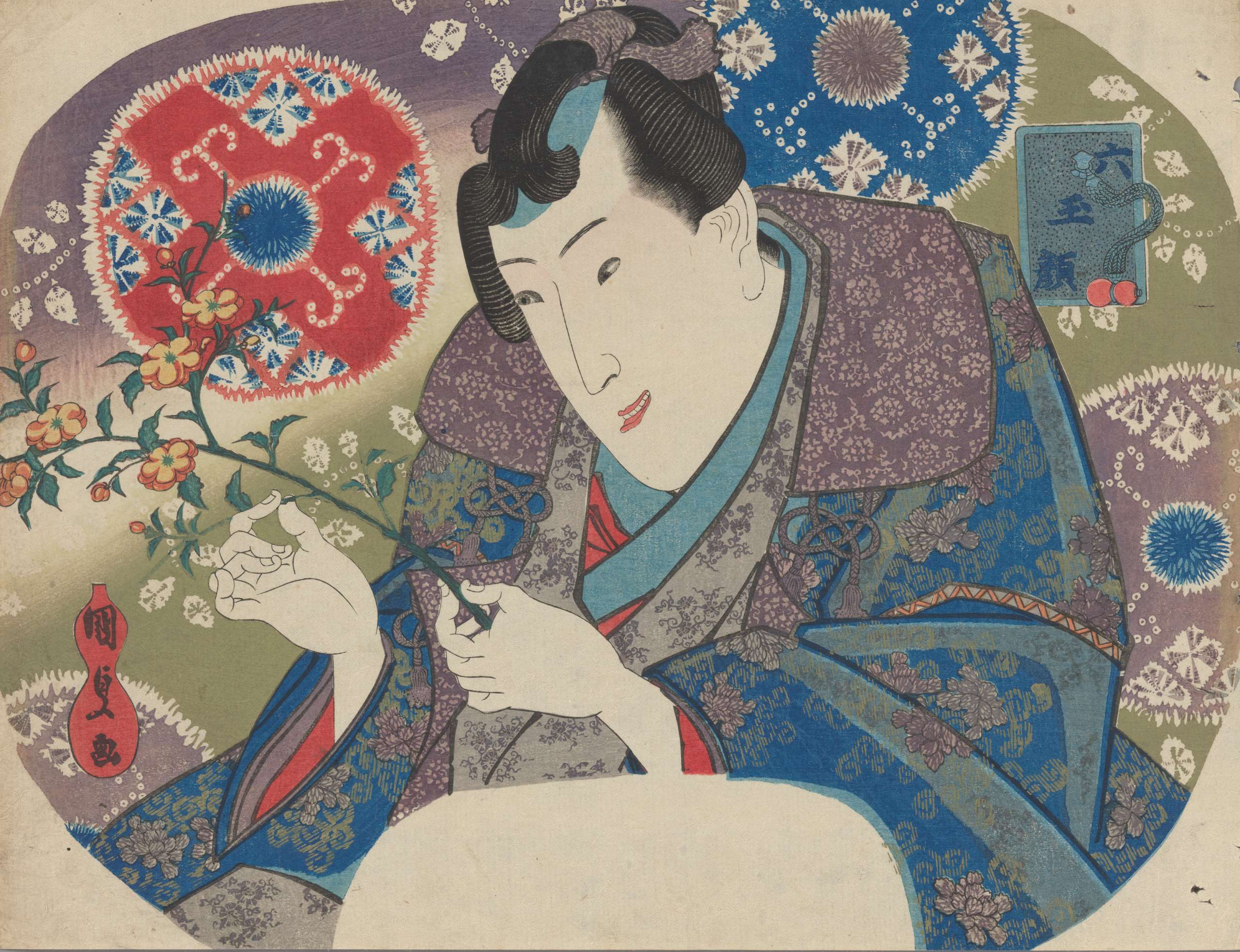 Mitsuuji with Mountain Roses (Yamabuki), from the series “Six Jewel Faces” (Mu tama-gao).
MET Accession Number:2019.3
Ref.: [LIB-2967.2022] Utagawa Kunisada: His world revisited / Catalogue 17, Exhibition March 17-21, 2021. — NY: Sebastian Izzard, LLC., 2021.
Mitsuuji with Mountain Roses (Yamabuki), from the series “Six Jewel Faces” (Mu tama-gao).
MET Accession Number:2019.3
Ref.: [LIB-2967.2022] Utagawa Kunisada: His world revisited / Catalogue 17, Exhibition March 17-21, 2021. — NY: Sebastian Izzard, LLC., 2021.




